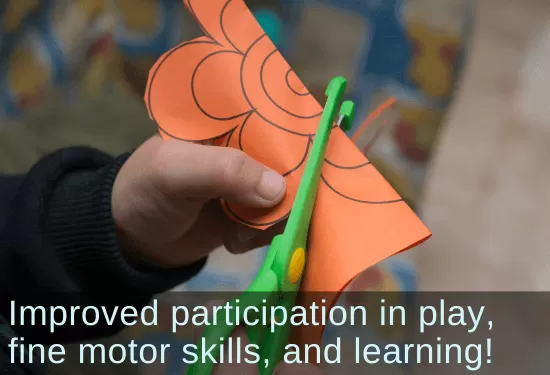Primitive Reflex Integration Case Studies
5-Year-Old Develops Attention and Fine Motor Skills
Rhythmic movements and reflex integration help with attention, fidgeting, mixed hand dominance, and fine motor skills.
This preschooler's enjoyment of the playful developmental movements taught in the Brain and Sensory Foundations program increased his participation and success. Read about his improvements in a range of issues.
Submitted by Jessica Ullmann, OT, Colorado

| Before | After |
|---|---|
| Limited attention span and focus | Increased ability to focus |
| Unable to sit still | Needs fewer verbal cues to stay seated |
| Mixed dominance | Starting to show right-hand dominance |
| Avoids working with tools such as pencils, crayons, scissors | Increased fine motor skills |
G is a five-year-old preschool student who started on my caseload when his teacher and parents became concerned that he lacked the skills needed to continue on to kindergarten in the fall.
"Some of the challenges that G has include:
- Very limited attention span and focus
- Impulsivity
- Even in play, G will spend limited time on any one activity and will quickly move from one thing to the next
- Mixed dominance
- Decreased fine motor skills
- Avoids activities that involve tool use (pencils, crayons, scissors)
- Has decreased core strength and motor planning"
I chose to introduce movements from the Brain and Sensory Foundations course. We did rhythmic movements to help him mature his brain stem so that he can improve his impulse control, focus and attention and help him to be able to learn and succeed in his preschool environment. I also wanted to help develop a good foundation for his reflex integration. I choose the TLR [Tonic Labyrinthine Reflex], ATNR [Asymmetrical Tonic Neck Reflex] and hand reflexes to focus on because of his difficulties with comprehension, poor fine motor skills, tense pencil grip and trouble forming basic shapes and letters in his name, and to help him develop a dominant hand for tool use.
In the beginning G had a very difficult time nodding his head along with the first rhythmic movement. He kept his head and neck stiff, and they would move as a unit. G liked helping to determine the speed of the movements and which song we sang. When he returned in the following weeks, G would request rhythmic movements right away. His head is moving more freely now, and he is able to assist with the head nodding for brief periods. For the reflexes I am providing the stimulation followed by the playful developmental movements.
"He has been able to do the isometric hand reflex activities. Participating in these activities has begun to:
- Increase G’s ability to focus and participate in his fine motor activities
- He is much more willing to come and sit at the table.
- He continues to need verbal cues to stay in his seat, but is needing much less of them.
- He also has been noted to be using his right hand more consistently when writing and using scissors."
For the 5 Step Balance G wanted to draw a picture. After acting out the drawing of a picture for the second time G stated that it was “fun” and then he wanted to draw a real picture. From this experience I learned how rhythmic movements and reflex integration activities can help improve a child’s attention and participation in play and learning.
[Edited for length and clarity; bullets and emphasis added]
*Disclaimer: The activities in the Brain and Sensory Foundations curriculum make use of the natural processes of neuroplasticity and development that are innately wired in the design of human beings to promote maturity and function. These activities appear to calm, organize, and mature the neuro-sensory-motor systems just as we see in the healthy development of human infants. Individual results may vary, and we do not claim to offer a diagnosis or cure for any specific condition or disorder. The Brain and Sensory Foundations activities appear to improve overall functioning resulting in measurable improvements for a range of conditions as demonstrated in over 1800 case studies from participants.

